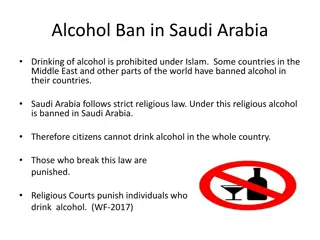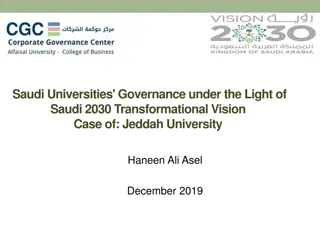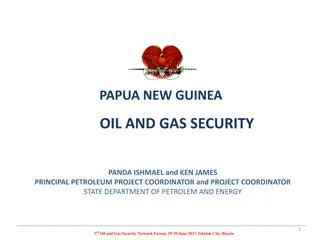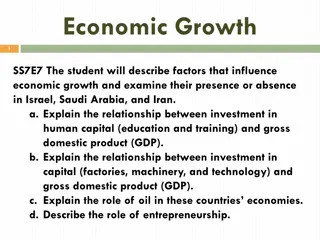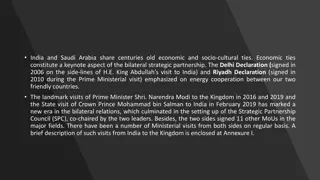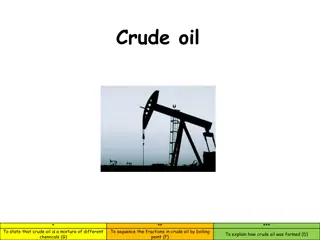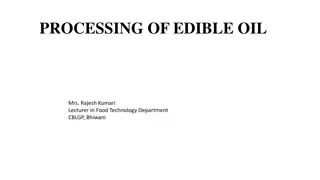Saudi Arabia's Energy Transition and Crude Oil Exports Analysis
The presentation explores Saudi Arabia's reliance on oil windfalls for economic prosperity, challenges posed by global energy transition, and the impact on crude oil exports. It highlights the country's evolving role in the global oil market, emphasizing the need to adapt to shifting energy demands and environmental concerns.
Download Presentation

Please find below an Image/Link to download the presentation.
The content on the website is provided AS IS for your information and personal use only. It may not be sold, licensed, or shared on other websites without obtaining consent from the author.If you encounter any issues during the download, it is possible that the publisher has removed the file from their server.
You are allowed to download the files provided on this website for personal or commercial use, subject to the condition that they are used lawfully. All files are the property of their respective owners.
The content on the website is provided AS IS for your information and personal use only. It may not be sold, licensed, or shared on other websites without obtaining consent from the author.
E N D
Presentation Transcript
Energy Transition and Saudi Arabias Crude Oil Exports Muhammad Javid IAEE: 2021 Online International Conference June 7-9, 2021 The views expressed in this presentation are those of the author and do not necessarily represent the views of KAPSARC.
Content Motivation and Objective Literature Review Background Modeling Framework and Data Empirical Results and Discussion Concluding Remarks and Policy Insights Saudi Arabia s Response to Climate Change 2
Motivation and Objective Oil windfalls have opened a window of great opportunities for Saudi Arabia Saudi Arabia's economy has become more prosperous Able to build a modern infrastructure Provide extensive social services to its residents Established a develop welfare system Strengthened macroeconomic indicators The oil sector continues to play a central role in the country's development, as government spending through oil revenues is a main driver of growth. 3
Motivation and Objective Muneef (2011)highlighted four factors that determine the role of Saudi Arabia in the global oil market: the size and production life of Saudi Arabia s oil reserves, the diversity of Saudi Arabia s oil export outlets, the country's large crude oil production capacity and the role of oil in the national economy Oil is crucial for Saudi economy but may create challenges for the sustainable and long- term development due to rapid structural changes in the energy market 4
Motivation and Objective There is a growing consensus that future oil demand may slow down because of: Increasing energy efficiency Technological advances in energy equipment Climate change and environmental policies Government incentives for renewable energy use Declining costs of renewable energy sources Widespread electrification 5
Motivation and Objective Energy transition is rapid in certain region of the world such as Europe, In such countries, the global energy demand is going to replace the high carbon energy system dominated by fossil fuels with a low carbon energy system dominated by renewables energy Oil is crucial for Saudi economy but may create challenges for the sustainable and long-term development due to rapid structural changes in the energy market Objectives to examine the impact of global renewable energy on Saudi Arabia s oil exports using Autometrics - a cutting edge econometric tool. The scope of the study is expanded by separately examining the impact of renewable energy on Saudi Arabia's crude oil exports to Asia and Europe. 6
Literature Review Most of the earlier studies are related to oil production behavior of Saudi Arabia and OPEC Griffin (1985) rejected the role of Saudi Arabia as a market leader Smith(2005) found strong evidence for cooperative behaviour among the OPEC members and found no evidence to support a dominant role of Saudi Arabia within OPEC Alhajji and Huettner (2008) found evidence to support the view that Saudi Arabia plays the role of dominant producer Alkhathlan et al (2014) found that Saudi Arabia's output behavior has varied over time in a systematic way, in response to market conditions and also to interruptions within OPEC To the best of our knowledge, there is no study that measure the impact of global renewable energy demand on Saudi Arabia's crude oil exports 7
World Energy Consumption by Energy Source Energy Consumption by Source (%) 50 600 Energy Consumption by Source (Quad Btu) 45 Petroleum and other liquids (%) 500 Renewables 40 Nuclear 35 400 30 Coal (%) Petroleum and other liquids 300 25 Natural gas 20 200 Natural Gas 15 100 Nuclear and , renewables (%) Coal 10 0 5 1980 1985 1990 1995 2000 2005 2010 2015 1980 1985 1990 1995 2000 2005 2010 2015 Data Source: US Energy Information Administration (EIA) 8
World Energy Consumption by Energy Source Oil continues to dominate total energy consumption Although oil consumption increased in absolute terms, however the share of oil in total energy consumption declined from 45% in 1980 to 33% in 2018. The share of renewable energy and natural gas remains small despite an increase in absolute terms The share of natural gas in total energy consumption increased from 18.4% in 1980 to 24% in 2018. The share of renewable energy increased from 9.7% to 15.2 % between 1980 and 2018. Share of coal consumption in total energy consumption remain stable despite increase in absolute term. 9
World Oil Market (1965-2019) 100.0 50% 90.0 Saudi Arabia s exports share of OPEC exports (%) World Oil Consumption 80.0 40% 70.0 Non OPEC Oil Consumption 60.0 30% MB/D 50.0 Non OPEC Oil Production 20% 40.0 Saudi Arabia s exports shares of Non- OPEC consumption (%) OPEC oil Exports 30.0 10% 20.0 Saudi Arabia's Oil Exports 10.0 0% 1965 1970 1975 1980 1985 1990 1995 2000 2005 2010 2015 0.0 1965 1970 1975 1980 1985 1990 1995 2000 2005 2010 2015 Data Source: BP Statistical Review of World Energy June 2020 and SAMA 10
Geopolitical events, Saudi Arabia crude oil exports, and crude oil prices 150 10 Libyan Crisis Global financial crisis Iran-Iraq War 125 8 High oil price and Demand 100 $/B (real 2019 dollars) 6 MB/D 75 4 Oil price collapse in 2014 Asian financial crisis 50 Iranian revolution 2 25 Second Gulf War First Gulf War Oil price shock 1973 0 0 1970 1975 1980 1985 1990 1995 2000 2005 2010 2015 Oil Price Oil Exports 11
Geopolitical events, Saudi Arabia crude oil exports, and crude oil prices Saudi Arabia has played a leading and cooperative role in stabilizing the market by expanding and contracting oil exports as demanded by global oil market conditions. Saudi Arabia s increased oil export during the oil market interruptions caused by the Iranian revolution in 1978, the Iran-Iraq War, the Iraqi invasion of Kuwait in 1990-1991 and the Second Gulf War in 2003 In the early 1980s, collapse in oil prices was largely due to global economic recession, reduction in oil consumption in industrialized countries, and the continued growth of non-OPEC supply Since 1998, after the Asian financial crisis, Saudi Arabia has played a more active role within OPEC by adjusting its export levels in response to the market. 12
Crude oil exports of Saudi Arabia: Regional Shares 120.0 The pattern of Saudi Arabia's crude oil exports has shifted dramatically toward Asia. Asian economies have become the main destination for Saudi Arabia's crude oil exports 100.0 (73.4% in 2019). (10 Years avearage share (%) 28.4 80.0 38.5 The share of crude oil exports to Asian economies has increased from an average of 28% in 41.8 53.3 1970-79 to an average of 65% in 2010-19 64.7 60.0 Strong growth and increasing population are the main reasons for the rising trend of oil exports in Asian countries 47.8 40.0 25.5 32.7 The share of crude oil exports to Western Europe decreased from an average of 48% in 1970- 15.9 11.9 79 to an average of 12% in 2010-19 20.0 24.1 22.6 The share of Saudi Arabia's crude oil exports to North America has also been declining since 16.5 16.1 8.1 0.0 the 1990s, falling from an average of 24% in 1990-99 to an average of 16% in 2010-19. 1970-79 1980-89 1990-99 2000-09 2010-19 North America South America Westren Europe Middle East Africa Asia Oil exports to the USA and Europe are declining due to efficiency measures and the shale revolution in the USA Data Source: SAMA 2019 13
Methodology Following Griffin(1985) we specify the following model to study the crude oil exports of Saudi Arabia It is assumed that OPEC oil exports( ??) is the difference between world oil demand (??)and non-OPEC supply (???) ??= ??? ,? ???(?,?) (1) An individual OPEC country s oil exports (??) is assumed to be some fraction ? of total OPEC crude oil exports (XO) ??= ? ?? (2) Equation (2) is modified by subtracting the individual country s oil exports from the total OPEC exports ??= ?? ?? (3) ?? Saudi Arabia s oil exports (???) can be written as fraction of other OPEC member countries ?? ?? (4) ???= ?? is a function of price Griffin (1985) assumed that the market share coefficient ?? 14
Methodology ????? ? (5) ?? ??= ?? Saudi oil exports depend not only on exports from other OPEC member countries but also on domestic oil supply, income, renewable energy supply in oil importer countries. We modify equation (5) to include domestic oil production, global income and global renewable energy consumption in the model. ?(????)???? (6) ???? ? ?? ????= ?? ????= 0+ ????+ ?t+ ????+ ??? +????+ ?? (7) The variables ?t, ????, ?t, ????, ?? , are the natural logarithms of Saudi oil exports (????), oil exports from the other OPEC member countries (????), real oil prices (?t), domestic oil supply (????), real GDP (??) respectively, while ???indicates renewable energy is the ratio of renewable energy consumption to total energy consumption and ?? is an error term 15
Methodology Many economic and non-economic factors have influenced Saudi Arabia s crude oil exports such as War in the Middle East, Asian currency crisis, policy changes, Global financial crisis, and the oil price collapse in 2014 among others we need an appropriate econometrics methodology that can consider not only economic determinants of Saudi Arabia oil exports but also other non-economic factors that might affect Saudi Arabia s oil exports Castle et al. (2020) argue that successful selection of econometric model requires robustness against many potential problems jointly, including outliers and shifts; omitted variables; incorrect distributional shape; non- stationarity; mis specified dynamics; and non-linearity, as well as inappropriate exogeneity assumptions (Castle et al. 2020) Model selection by Autometrics with tight significance levels and bias correction is a successful approach that allows to handle multiple breaks. Impulse indicator saturation allows many breaks in modelled data (Doornik, 2009; Doornik and Hendry, 2009). 16
Data Variable Notation Variable Definition Data Source Saudi Arabia crude oil exports thousand barrels per day The data on oil exports are from SAMA (2020 ??? It is the difference between OPEC exports and Saudi Arabia exports. Annual Statistical Bulletin 2020. OPEC https://asb.opec.org/data/ASB_Data.php Crude oil exports of rest of OPEC member countries in thousand barrels per day. ??? The GDP of trading partner of Saudi Arabia is divided by the population. The data are from the World Bank s World Development Indicators. GDP per (2010 constant price) ? Annual Statistical Bulletin 2020. OPEC Domestic Production of Crude oil ??? Real price of crude oil US dollars per barrel ($ 2019) bp Statistical Review of World Energy June 2020 ? bp Statistical Review of World Energy June 2020 Renewable energy as percentage of total primary energy consumption (Exajoules) ?? 17
Sample Selection Equation (7) is estimated using Autometrics with Super Saturation for Saudi Arabia crude oil exports for three regions: Full Sample : Japan, China, Korea, Rep., India, Singapore, Thailand, Pakistan, Bahrain, Malaysia, Indonesia, France, Italy, Spain, Netherlands, United Kingdom, Belgium, Germany, United States Asian Countries included in Sample are: Japan, China, Korea, Rep., India, Singapore, Thailand, Pakistan, Malaysia, Indonesia European Countries included in Sample are: France, Italy, Spain, Netherlands, United Kingdom, Belgium, Germany 18 18
Empirical Results: Autometrics with Super Saturation (IIS, DIS, SIS, TIS) ??? 1 ??? 2 ??? ??? 1 ??? 2 ??? ??? 1 ??? ???? ??? 1 ??? ??? 2 ???????? Long Run Elasticities ??? ??? ??? ??? ??? Full Sample Asia Europe Diagnostic Tests R2 Adj-R2 ARCH JB HET RESET 0.18b -0.42a 0.36b ? ? ?? ?? ?? 0.98 0.97 0.99 0.99 0.99 0.98 0.97a -0.31b -0.21b 0.07b 0.025 (0.874) 1.01 (0.603) 1.538 (0.204) 0.567 (0.574) 3.912 (0.055) 1.521 (0.467) 1.356 (0.281) 3.116(0.063) 0.432 (0.648) 2.887 (0.236) 1.726 (0.314) 0.481 (0.623) -0.49a -0.82a 0.19a -0.22a 1.14b 0.90a -1.60a 0.13a 1.84a -1.14a 0.99a -1.59b -1.36b -1.52 1.56a -0.11b Year of Dummy 1986 1997 1985 1990 2002 1988 1984 1980 1981 2006 Types of Dummies DIS IIS TIS TIS ISS TIS DIS IIS DIS SIS Full Sample 0.762 0.995 -0.640 0.371 -0.133 Asia Europe 0.287 -0.71b -1.63a 11.1a 0.44a 0.07b 1.56a -0.11b -2.33a -2.23a 17.97a -0.262 0.519 -0.164 0.287 -0.49a 0.13b 1.84a -0.15a -0.23a -0.38b -0.02 0.92b -0.60a -1.80a ?? -0.517 0.130 -0.582 0.616 0.851 0.277 The letters a, b and c indicate rejection of the null hypothesis at the 1%, 5% and 10% significance levels, respectively 19
Restriction on Long-run Elasticities of rest of oil exports Restrictions on the Long-run Elasticities of rest of oil exports ? Constant market sharing (? = 1,? = 0); Market sharing (? = 1,? < 0,?? ? > 0); and Partial market sharing (? > 0,? < 0,?? ? > 0). For Full sample H0:? = 1, t = 12.9 For Asian countries H0:? = 1, t= -4.23 For European countries H0:? = 1, t= - 4.13 For all the full sample and European countries, the constant market sharing hypothesis ( =1, =0), the market sharing hypothesis ( =1, >, <, 0) and the partial market sharing hypothesis ( > 0, >, <, 0) can be rejected For Asian countries partial market sharing (? > 0,?? ? > 0) may hold 20
Initial Findings and Policy Insights The coefficient of exports from the other OPEC member countries is negative and statistically significant for full sample and European countries, whereas this coefficient is positive for Asian countries. The positive coefficients of exports from the other OPEC member countries for the Asian countries indicate that Saudi Arabia oil exports vary with the exports of other OPEC nations. Positive and statistically significant coefficient of price for Asian countries, indicates that market share changes with price changes An increase in the global economic activity would demand more oil from Saudi Arabia whereas domestic oil production in oil importing economic would imply the opposite. 21 21
Initial Findings and Policy Insights Negative and statistically significant coefficients of global renewable energy for all three estimated models, suggest that future Saudi Arabia oil exports may be affected by the development of alternative energy sources. The estimated value of long-run elasticities of the key drivers of Saudi Arabia s oil exports are substantially varies across the regions. The differences in the long-run elasticities for the two regions might be due to structural characteristics of the economies of the regions and alternative energy resources. From the policy point of view, the different elasticity estimates can be used by policymakers to quantify the impact of policies targeted at specific region. 22 22
Initial Findings and Policy Insights The energy transition can be useful to Saudi Arabia for industrial transformation and the adoption of a broader economic diversification strategy. The strategy of economic diversification through industrial transformation could help the country continue to make the most of its abundant resources while achieving the long- term goals of more resilient and productive economy. The other option for Saudi Arabia to address this challenge is to save oil revenues to accumulate financial assets or invest in physical assets. Policy makers should continue to tailor the country's oil export policy to structural changes and regional characteristics. 23 23
Saudi Arabias Response to Climate Change As an active and responsible member of the international community, Saudi Arabia is proactively contributing to renewable energy generation: Saudi Arabia has launched several climate change initiatives based on its competitive strengths and expertise in the energy sector, in collaboration with leading international and national partners. NEOM, in conjunction with Air Products and ACWA Power, is planning to build green electrolyser plant using 4 GW of renewable power. A unique and important initiative has been taken between Saudi Arabia and Japan to establish an international supply chain for blue ammonia. Japan received the world's first shipment of blue ammonia in 2020 from Saudi Arabia. Saudi Arabia s is planning to produce 50% of the energy used for electricity generation using renewable energy by 2030, with the rest supplied by gas. 24 24
Saudi Arabias Response to Climate Change Saudi Arabia is planning to develop the circular carbon economy (CCE) framework, through which carbon emissions can be managed in a comprehensive and integrated manner to mitigate the impacts of climate challenges. CCE framework was endorsed by the G20 leaders. The lowest auction price discovered in the latest (second) round of National Renewable Energy Program (NREP) of Saudi Arabia is ~USD 0.0104/kWh 25 25
THANK YOU 26





